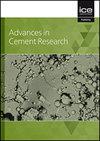Expansion of concrete by secondary ettringite formation, caused by fine recycled aggregates contaminated with gypsum
IF 1.3
4区 工程技术
Q3 CONSTRUCTION & BUILDING TECHNOLOGY
引用次数: 0
Abstract
Recycled aggregates, and especially the fine (0/4 mm) fraction, are often contaminated with sulfates coming from gypsum residues on the demolition site. When these aggregates are used in concrete, the sulfates can induce internal sulfate attack which causes the expansion of concrete. Standard EN206 sets the water soluble sulfate limit at 0.2 % by weight of the aggregate but other studies suggest this limit could be safely increased. In addition to the sulfate content, other parameters like the porosity and alkalinity of a mix have been seen to influence the swelling results. In this study, the different proposed sulfate limits are evaluated on concrete made with 100 % fine recycled aggregates. It is also researched whether mixing parameters could change the swelling amount regardless of sulfate content. The results showed that the incorporation of fine recycled aggregates with sulfate contents up to 0.8 mass% is safe when combined with coarse natural aggregates. If coarse recycled aggregates are used, the sulfate content of fine recycled aggregates could reach up to 0.3 %. The swelling caused by these sulfate levels was not high enough to be influenced by porosity or alkalinity.再生细骨料受石膏污染,造成混凝土二次钙矾石膨胀
回收骨料,尤其是细骨料(0/4mm),经常被来自拆除现场石膏残留物的硫酸盐污染。当这些骨料用于混凝土时,硫酸盐会引起内部硫酸盐侵蚀,从而导致混凝土膨胀。标准EN206将水溶性硫酸盐限值设定为骨料重量的0.2%,但其他研究表明,可以安全地提高该限值。除了硫酸盐含量外,还发现混合物的孔隙率和碱度等其他参数会影响溶胀结果。在本研究中,对使用100%细再生骨料制成的混凝土的不同硫酸盐限值进行了评估。还研究了混合参数是否会改变溶胀量,而与硫酸盐含量无关。结果表明,硫酸盐含量高达0.8质量%的细再生骨料与天然粗骨料结合是安全的。如果使用粗再生骨料,细再生骨料的硫酸盐含量可达0.3%。由这些硫酸盐水平引起的溶胀不足以受到孔隙率或碱度的影响。
本文章由计算机程序翻译,如有差异,请以英文原文为准。
求助全文
约1分钟内获得全文
求助全文
来源期刊

Advances in Cement Research
工程技术-材料科学:综合
CiteScore
3.70
自引率
5.00%
发文量
56
审稿时长
3.2 months
期刊介绍:
Advances in Cement Research highlights the scientific ideas and innovations within the cutting-edge cement manufacture industry. It is a global journal with a scope encompassing cement manufacture and materials, properties and durability of cementitious materials and systems, hydration, interaction of cement with other materials, analysis and testing, special cements and applications.
 求助内容:
求助内容: 应助结果提醒方式:
应助结果提醒方式:


